제2외국어 채택 2년도 안돼 제1외국어로
K콘텐츠 인기에 초3학년부터 한글 공부
학습 수요에 못 미치는 교원 수..."현지 한국어 교사 양성 시급"
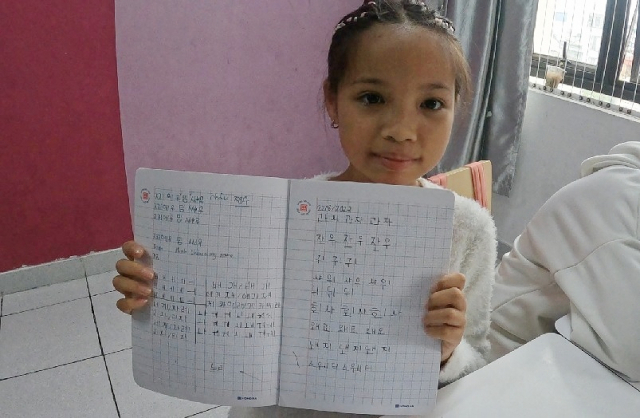
[하노이=코리아헤럴드] 한국에서 비행기로 5시간 떨어진 베트남 하노이에는 한국어의 인기가 그 어느 곳보다 뜨겁다.
초등학교 3학년에 해당되는 8세 어린이들이 한국어를 영어와 함께 제2외국어로 배우고 있고 한국어능력시험(TOPIK) 응시자 수는 2021년 8,000명에서 2022년 28,450명으로 3배 가까이 늘었다.
베트남 교육훈련부는 지난 2019년 한국어를 제2외국어로 승인한 데 이어 2021년에는 독일어와 함께 제1외국어로 추가 선정했다. 채 2년이 안되어 제1외국어로 승격된 것이다.
베트남 교육 과정 상 제1외국어는 초등학교 3학년부터, 제2외국어는 중등학교부터 선택 과목으로 배우게 된다. 현재 한국어와 독일어를 포함해 총 7개국어 (영어, 러시아어, 프랑스어, 중국어, 일본어)가 제1외국어로 채택되어 있다.
주베트남한국대사관 산하 하노이 한국교육원의 원광석 원장은 한국어보다 13년 앞서 2003년 제1외국어가 된 일본어는 지난해 기준 베트남 총 121개의 초·중·고등학교에서 채택되었지만, 한국어는 2021년 지정 후 현재 79곳에서 수업이 이뤄지고 있다고 말했다.
한국교육원에 따르면 지난해 베트남 전역에 걸쳐 한국어 수업을 들은 초·중·고등 학생은 총 11,639명. 하노이에서만 초등학교 1곳, 중학교 33곳, 고등학교 10곳에서 6,000명이 넘는 학생들이 한국어를 배웠다.
알프레드 노벨 학교
올해 초 본지가 찾아간 초·중·고 통합 알프레드 노벨 학교(Alfred Nobel School)의 한 교실에서는 20여 명의 베트남 학생들이 한글을 배우고 있었다.
한글 기초와 기본 어휘를 가르치는 5학년 대상의 한국어 수업이었다. 대부분의 학생이 막 한국어에 입문했기에 수업은 영어로 진행됐다.
학생들은 한국인 선생님의 지도 아래 한글의 자음과 모음을 직접 공책에 쓰면서 "과자"와 같은 간단한 단어들을 만들어보거나 기본적인 회화 표현을 연습했다.
또 다른 교실에서는 학생들이 선생님과 함께 다양한 색깔의 팽이를 만들며 한국어로 색을 표현하는 방법을 배우고 있었다.
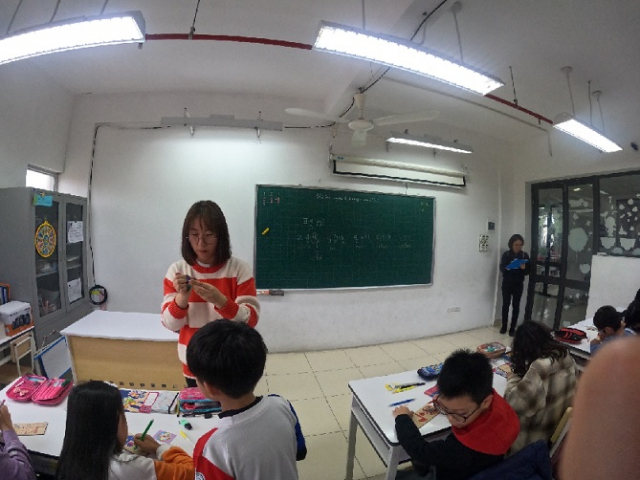
학교 관계자는 “저학년 학생들을 대상으로 한 외국어 교육에서 가장 중요한 요소는 흥미 유발”이라며 “알프레드 노벨 학교의 초등 과정 한국어 수업은 다양한 게임과 미술 활동을 통해 진행된다”고 말했다.
지난 2020년 한국어를 제2외국어로 채택한 알프레드 노벨 학교는 하노이에서 초등학생 대상 한국어 교육 과정을 시작한 최초의 학교이며 현재 3학년부터 11학년까지 총 16개의 한국어반을 운영 중이다. 베트남 초등학교는 6세~10세까지 5년 과정으로 1학년~5학년으로 구성돼 있다.
이 학교의 응옥 짬 교장에 따르면 지금까지 400명이 넘는 초등학생들이 한국어를 배웠고 매 학기 평균 70명의 학생들이 한국어 수업을 듣고 있다.
“전세계적으로 한국 대중문화의 인기가 높아지는 가운데 더 많은 베트남 학생들이 한국으로 유학가거나 베트남에 있는 한국 기업에 취업하기 위해 노력하고 있습니다. 베트남 정부가 한국어를 제1·2외국어로 지정하기 전부터 한국어 학습 수요는 이곳 학생들 사이에서 항상 높았습니다.”
응오쟈뜨 중학교
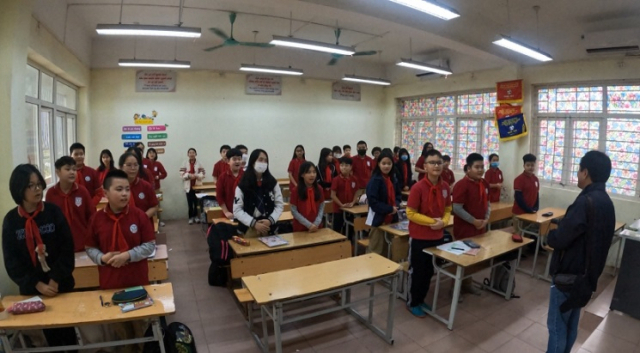
한국어가 베트남 공교육 과정에 채택되기 전인 2016년 베트남 교육훈련부는 하노이와 호찌민 소재 8개의 중학교에서 한국어 시범 교육을 진행했다. 하노이 중심가에 위치한 응오쟈뜨 중학교는 그 중 한 곳이었다.
현재 응오쟈뜨 중학교(Ngo Gia Tu Middle School)에는 6~9학년에 걸쳐 총 5개의 한국어반이 있으며 각 교실의 한국어 학습자 수는 30~40명에 이른다.
8학년의 칸 푸옹은 본지와 한국어로 진행된 인터뷰에서 “한국어능력시험을 준비하고 있다”며 기회가 된다면 한국으로 유학을 떠나고 싶다고 말했다.
“한국 기업에서도 일을 하고 싶습니다. 지금은 비록 한국어 실력이 부족하지만 계속 열심히 공부할 것입니다.”
푸옹과 마찬가지로 한국에서 공부하는 날을 꿈꾸는 8학년 학생 타인 레는 한국 드라마와 예능의 열혈 팬이다. 그는 본지와의 인터뷰에서 “한국 미디어 콘텐츠를 자막없이 보는 것이 학습 목표”라고 말했다.
응오쟈뜨 중학교의 학생들은 한국어 수업에서 교과서 뿐만 아니라 한국 음악과 드라마 등 다양한 시청각 자료를 통해 한국어의 기초 문법, 단어, 문장 구조 등을 배우고 있다.
응오쟈뜨 중학교의 유일한 한국인 선생님인 최명천씨는 “한국어 수업을 듣는 학생 수가 계속 증가하고 있다”며 “한국어 수업을 신청한 학생이 너무 많아 두 개의 수업을 동시에 진행해야 했던 적도 있었다”고 전했다.
하노이국립외대부속고등학교
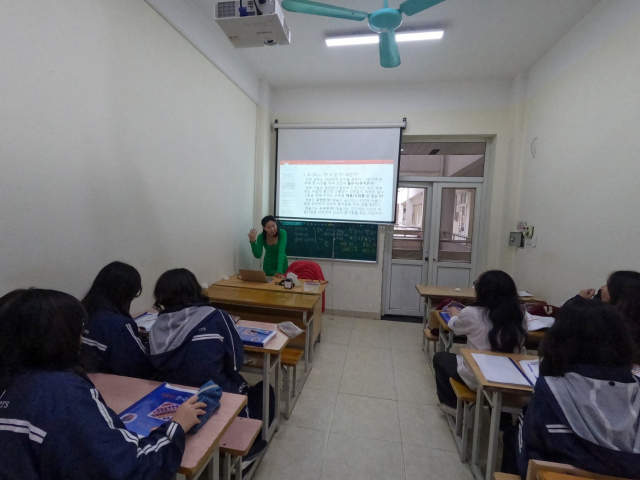
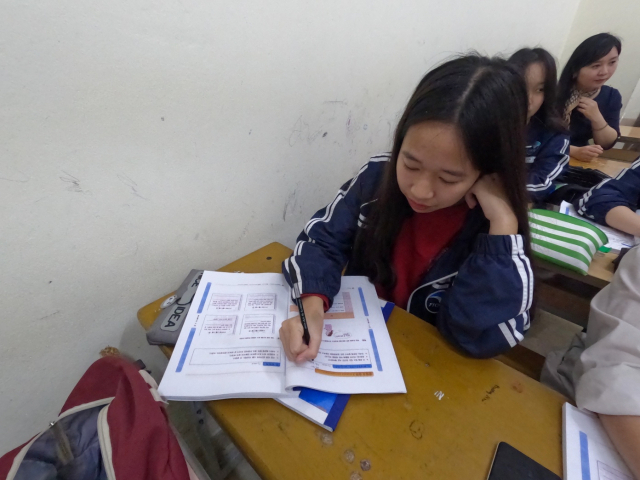
하노이국립외대 캠퍼스 안에 위치한 외국어전문고등학교(Foreign Language Specialized School)에는 260명이 넘는 학생들이 한국어를 전공으로 삼거나 선택 과목으로 배우고 있다.
하노이국립외국어대학교 부설 학교인 FLSS는 베트남에서 외국어를 전문적으로 가르치는 유일한 고등학교로 지난 2017년 한국어를 정규 교육 과정에 편입시켰다.
본지가 방문한 했을 때 FLSS의 12학년 대상 한국어 교실에서는 한국어 문법에 대한 수업이 한창이었다. 고급 문법과 어휘에 대한 강의가 진행된 해당 수업은 FLSS에서 한국어를 전공으로 선택해 공부하는 10~12학년의 학생들을 위한 8개반 중 하나였다.
학교 관계자에 따르면 FLSS에는 현재 총 80명의 한국어 전공자가 있다. 여기에 한국어를 전공하지 않지만, 선택 과목으로 공부하는 학생들은 총 183명이다.
FLSS의 베트남인 한국어 교사 응우옌 지앙에 따르면 한국어 전공자 대부분이 중학교 때부터 한국어를 공부해왔으며 이들은 주로 한국으로 유학을 떠나거나 베트남에서 한국어 능력을 살릴 수 있는 직업을 갖고 싶어한다고 한다.
“고학년 한국어 전공자들의 경우 한국어능력시험에서 4급 이상을 받기 위해 열심히 노력합니다. 대다수의 학생들이 졸업할 즈음에는 최고 레벨인 6급 혹은 5급을 취득할 정도의 실력을 갖추게 됩니다.”
최근 한국어능력시험에서 5급을 받은 응우옌 린 학생은 “대학에서도 한국어를 전공할 계획”이라며 “베트남어와 한국어에 모두 유창한 졸업생들에게 더 좋은 취업 기회가 있다”고 말했다.
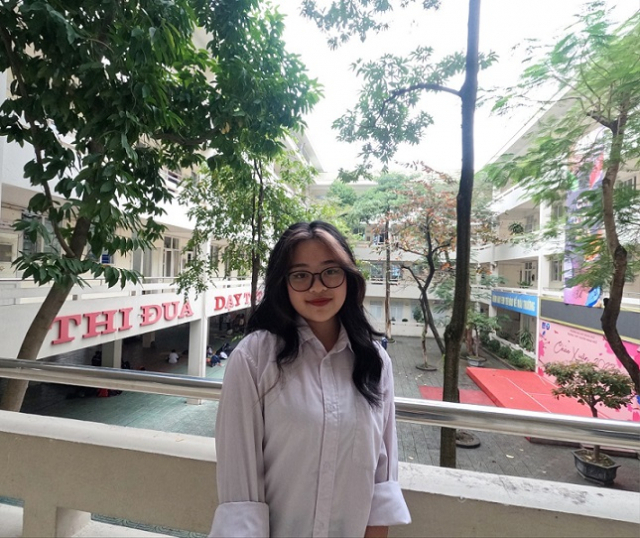
K-POP 팬이기도한 린은 방과 후에 친구들과 함께 음악을 듣고 춤을 추며 한국 문화에 흠뻑 빠져 있다고 덧붙였다.
“한국어를 공부하기 전에는 K-POP 노래를 들을 때 가사를 이해하지 못했지만 이제는 모든 가사의 의미를 알 수 있다. 놀라운 변화다.”
베트남 내 한국어 열풍 속 FLSS 한국어 전공반에 입학하기 위한 경쟁도 나날이 치열해지고 있다.
FLSS 교장 응우옌 푸 찌엔은 “한국어 전공반 모집 인원은 매년 25명으로 정해져 있는데 작년에 200명이 넘는 학생들이 지원했다”고 말했다.
과거 한국어반 졸업자들은 대학에 진학해서도 한국어를 전공하는 경우가 많지만, 최근에는 경영, 컴퓨터공학 등 취업 전망이 밝은 학과에 입학해 한국어 실력과의 시너지 효과를 낼 수 있는 진로를 선택하는 추세를 보이고 있다고도 전했다.
“FLSS의 한국어 전공 학생들은 학교에서 한국어를 집중적으로 공부하기 때문에 대부분 일상 대화를 이해하는 데 어려움이 없습니다. 학생들이 한국어 실력을 다른 학문 분야와 융합한다면 본인만의 차별화된 경쟁력을 갖출 수 있다고 생각합니다.”
하노이국립외국어대학교
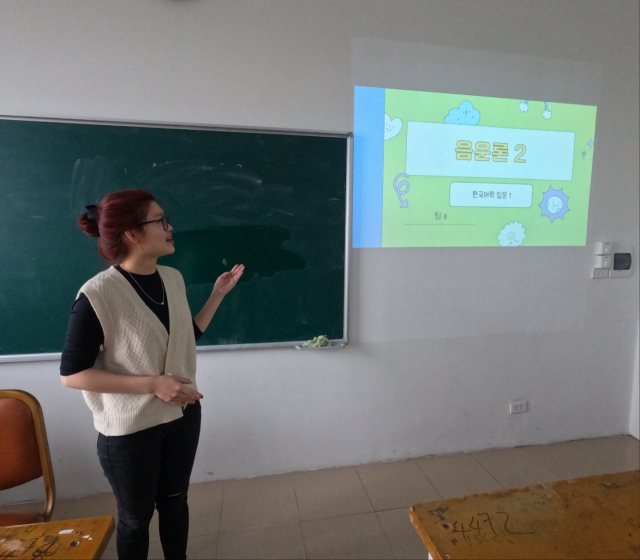
같은 날 오후 본지가 방문한 하노이국립대학교 외국어대학교(Vietnam National University – University of Languages and International Studies, ULIS) 한국어, 한국문화학부의 한 수업에서는 한국어 음운론에 대한 학생들의 발표가 이어지고 있었다.
20명의 수강생들 앞에서 한 학생이 한국어 음운의 음성적 특징에 대해 소개하자 학생들은 저마다 공책에 발표 내용을 필기하거나 질문을 하며 수업에 열정적으로 참여했다.
해당 교실은 ULIS 한국어, 한국문화학부의 세부 전공인 언어학 수업으로 학생들은 음성학과 음운론을 배운다.
도 프언 투이 ULIS 한국어, 한국문화학부 부학장은 “언어학 수업의 목표는 한국어에 대한 지식을 어느 정도 갖춘 고학년 학생들로 하여금 한국어에 대한 더 깊은 이해를 돕는 데 있다”고 설명했다.
투이 부학장에 따르면 재학생들은 3학년 때 자신의 관심 분야와 진로에 맞춰 세부 전공을 선택해 관련 수업을 듣게 된다. ULIS 한국문화학부에는 한국어와 한국 문화, 한-베통역, 언어학 그리고 한국어 교육의 총 4가지 세부 전공이 개설돼 있다.
ULIS를 포함해 현재 베트남에서 한국어 관련 학과를 개설해 운영 중인 대학교는 51곳에 달한다. 최근 한국어 배우기 열풍이 불면서 한국어과의 입학하기 위한 경쟁도 치열해졌다.
지난해 ULIS 한국문화학부의 입학 경쟁률은 3:1을 기록했으며 최근 5~6년간 지원자들의 입학 시험 점수는 대학의 전체 학과 중 최상위권이었다.
쩐 티 흐엉 ULIS 한국문화학부장은 “ULIS에서 한국어와 한국 문화를 전공하려는 학생들의 수가 점차 증가하고 있다”며 “다른 전공의 학부생들도 제2외국어로 한국어를 공부하는 경우가 많다” 전했다.
올 해 기준 900여 명의 학생들이 ULIS에서 한국어를 전공하고 있으며 각 학년 별로 8개의 수업이 운영 중이다.
이들의 주요 학습 동기는 단연 한류였다.
엑소의 오랜 팬이라고 밝힌 3학년 여학생 레 티 마이 흐엉은 본지와의 인터뷰에서 “K-pop 아이돌을 위한 한-베 통역사가 꿈”이라며 “언젠가 엑소를 만나기 위해 중학교 때부터 한국어를 공부해왔다”고 말했다.
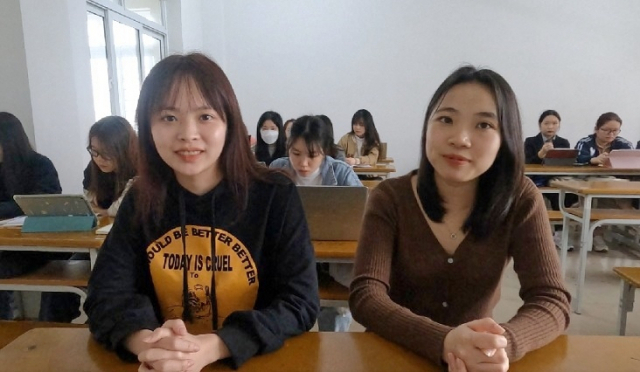
그의 동급생 호앙 푸옹 짱 또한 졸업 후 통역사로서의 꿈을 품고 있었다.
“2012년부터 한국의 드라마와 영화를 한국어를 독학해왔습니다. 한국 미디어 콘텐츠를 보는 것을 정말 좋아하기 때문에 졸업 후 한-베 영상 번역가로 일하는 것이 목표입니다.”
짱은 “한국어를 배우는 가장 좋은 점은 영어나 베트남어 자막 없이 한국 드라마와 영화를 볼 수 있다는 것”이라며 “예전과는 달리 한국 아이돌들이 생방송 음악 프로그램에서 그 어떤 말을 해도 다 이해할 수 있어서 기쁘다”고 덧붙였다.
취업 기회 또한 이들이 한국어를 배우는 주된 이유 중 하나다.
짱은 “작년에 한국과 베트남은 수교 30주년을 맞이했다”며 “두 국가 간 깊어지는 경제적 협력 관계 덕분에 한국어가 유창한 베트남 대학생들이 한국 기업에서 일할 수 있는 기회가 더 많아졌다”고 전했다.
학습 수요에 비해 턱없이 부족한 교원
베트남에서 한국어 배우기 열풍이 뜨거워지고 있는 가운데 일각에서는 한국어 교원의 수가 나날이 증가하는 학습 수요를 따라가지 못하고 있다고 지적한다.
베트남 최대항구도시 하이퐁에 위치한 쩐푸 고등학교(Tran Phu High School for the Gifted)의 돈 타이 썬 교장은 “베트남인 한국어 교원 양성이 시급”하다며 “쩐푸고에서는 한국인 출신 한국어 선생님들께서 훌륭한 역할을 하고 있지만, 베트남 내 지속적인 한국어 교육과 학술적 연구에 중요한 역할을 할 베트남인 교원이 더 많아져야 한다”고 말했다.
실제로 본지가 방문한 현지 학교들의 한국어 교원 수는 2~3명에 불과했고 대부분 한국에서 파견된 한국인 선생님들이었다.
쩐푸고는 지난 2021년 한국어를 제2외국어 교육 과정에 편입시켰고, 현재 10학년과 11학년을 대상으로 총 4개의 한국어 수업을 제공하고 있다. 한국어 학습자는 현재 140명이고, 한국어 선생님은 4명이다. 이 중 두 명은 한국인, 나머지 두 명은 베트남인이다.
하노이 한국교육원은 본지와의 인터뷰에서 교원 부족 문제를 해소하기 위해 현지 학교들에 한국인 교원을 지속해서 파견하고 현지 교원 양성을 위해 지원과 협력을 아끼지 않겠다고 밝혔다.
원광석 한국교육원장은 “올해 중으로 현지에서 활동 중인 베트남인 한국어 교육자분들을 모시고 워크샵을 진행할 계획”이라며 “서울대 한국어교육학과의 교수님들을 초대해 양질의 한국어 교육에 대해 모색하는 시간을 가질 예정이다”고 말했다.
하노이 한국교육원은 2020년 교육부가 설립한 재외교육기관으로 베트남 초중고등학교에 한국어 교원과 교재 개발과 지원하며 현지 한국어 및 한국 문화 보급과 확대에 첨병역할을 톡톡히 하고 있다.
“원어민 한국어 교사의 수를 늘리는 것과 함께 현지 교원을 양성하는 투 트랙 전략으로 지원 사업을 전개하며 베트남 내 한국어 교육 수준을 높이는 데 노력하겠다.”
원문
[Hello Hangeul] Inside Vietnam’s Korean learning boom
HANOI, Vietnam – Located a five-hour flight from Seoul is a country where the Korean language's popularity is second only to its homeland of South Korea.
Here, kids as young as 8 -- or elementary school third grade -- are learning Korean at school, although not as a compulsory subject. This is the same age when they start learning English.
Another indication of the Korean language boom in Vietnam is the number of those who take the Test of Proficiency in Korean (TOPIK), an exam for non-native Korean speakers. This figure more than tripled between 2021 and 2022, from under 8,000 to a total of 28,450.
Korean is among seven world languages selected by the local educational authorities that can be taught as a "first foreign language,"which means that it can be taught from the third grade of elementary school, explains Won Kwang-seog, director of the Korea Education Office under the Korean embassy in Hanoi.
This comes after Korean was chosen as a second foreign language in 2019, which means it could be taught in middle and high schools.
Korean was the latest addition to the first foreign language league in 2021, along with German. They joined five others -- English, Chinese, Japanese, French and Russian.
“Vietnam selected Japanese as one of the main foreign languages for study in 2003, nearly 13 years before it launched a pilot program to offer Korean language classes at middle schools in 2016,” Won said.
Despite the late start, schools have adopted Korean at a remarkable pace. Last year, there were 11,600 students learning Korean at 79 elementary, middle and high schools across the nation. In comparison, Japanese courses were available at 121 schools.
In Hanoi alone, Korean is taught at one elementary, 33 middle and 10 high schools with the total number of learners exceeding 6,100.
In February this year, The Korea Herald visited some of the schools in Hanoi to explore the Korean learning trend and meet with young students and their teachers.
Alfred Nobel School
On Feb. 8, some 20 fifth grade students at Alfred Nobel School in Hanoi, a private integrated school offering elementary, middle and high school education, were learning the Korean alphabet from a native Korean teacher.
The class was taught in English, as most students’ Korean proficiency was at a beginner's level.
Students practiced writing basic letters of Hangeul in their notebooks and pronouncing simple Korean words like “gwaja (snack)” and “dwaeji (pig).”
Another class for fifth graders made various "paengi," Korean spinning tops, as a Korean teacher taught the Korean words for different colors.
A Korean language teacher and her fifth-grade students make "paengi," Korean spinning tops, during a class on Feb. 8, 2023. (Choi Jae-hee / The Korea Herald)
The school’s Korean classes involve a lot of games and art activities to intrigue early grade schoolers’ interest in the foreign language, a school official said.
The school, which adopted Korean as a second foreign language subject in 2020, currently runs a total of 16 Korean language classes for students in grades 3-11. It is the first and only school in Hanoi that teaches Korean to elementary students. A typical elementary school in Vietnam has grades 1 to 5.
Since the first year, more than 400 students in elementary grades have chosen to study Korean. Each semester, an average of 70 take the Korean course by choice, Ngoc Tram, principal of the school, told The Herald.
“Amid the great popularity of Korean pop culture, a rising number of Vietnamese high schoolers seek to study abroad in Korea or enter Korean companies in Vietnam. There was a high demand for Korean language learning among our students, even before the Vietnamese government designated Korean as one of its first foreign languages in 2021,” she said.
Ngo Gia Tu Middle School
Before including Korean as one of the first foreign language subjects for the school curriculum, Vietnam had conducted a pilot program at eight middle schools in Hanoi and Ho Chi Minh. Ngo Gia Tu Middle School was among them.
Three eighth-grade students at Ngo Gia Tu who have been studying Korean for the last three years sat down with The Herald to share their goals and dreams.
Khanh Phuong, whose favorite Korean phrase is “saranghae (I love you),” is planning to take the TOPIK. She is taking the test because she wants to study abroad in Korea later on.
“I want to work at Korean companies. My Korean is not good enough, so I will study harder,” she said.
Another of the trio, Thanh Le, who also wants to study in Korea in the future, said she is a huge fan of Korean TV dramas and entertainment shows.
“I want to understand Korean TV shows without subtitles,” she said.
Ngo Gia Tu currently has five Korean language classes, with each class consisting of 30-40 students.
Students at the school are taught basic grammar, words and sentence structures through textbooks and audiovisual materials like K-pop songs and YouTube videos, according to Choi Myung-chun, a native Korean teacher at the school.
“The number of students enrolled in Korean language courses here has been on the rise. There was one time when I had to teach two classes simultaneously, as too many students applied for my Korean course,” Choi said.
Foreign Language Specialized School
At the Foreign Language Specialized School, a public high school in Hanoi, there are more than 260 students who aspire to be fluent in Korean.
On the morning of Feb. 10, a group of eight 12th graders majoring in Korean were attending a lecture on Korean grammar.
A native Korean teacher was explaining advanced verbs and nouns, using a course book titled “Seoul National University Korean,” developed by the university for Korean language learners.
The class was one of the school’s four classes – with 80 students in total – whose students have chosen Korean as their first foreign language, which makes it their main language of study as a major. Another 260 students are learning the language as a second foreign language.
Most of the Korean majors at the school have studied the language since middle school, said Nguyen Giang, a Vietnamese Korean teacher there. The students pursue study abroad opportunities in Korea or hope to establish a career that utilizes their Korean skills.
“Senior Korean majors work hard to achieve at least a level 4 on TOPIK. By the time they graduate, many score level 5 or 6 on the exam,” she said.
One of her students, Nguyen Linh, recently passed TOPIK level 5. She is now preparing to pass level 6 for extra points when applying to the Korean department of local universities.
“I am planning to major in Korean language at college, because job prospects for college graduates fluent in both Korean and Vietnamese seem to be bright,” Linh said.
She said that she and her classmates willingly immerse themselves in the sea of Korean culture after class as an extension of their studies.
“In the past, I couldn't understand a single word when listening to K-pop songs, but now I can understand what all the lyrics mean, which is amazing,” she said.
The FLSS, the only secondary school in Vietnam specializing in teaching foreign languages, added Korean to its official curriculum in the academic year of 2017-2018. Since then, Korean has been available as a first and second foreign language for students in grades 10-12.
Currently, it has a total of 80 students majoring in Korea as a first foreign language in four classes, while 183 other students learn it as a second foreign language in six classes.
There is tough competition to major in Korean, said Nguyen Phu Chien, principal of the FLSS. “We accept 25 new students for the Korean curriculum. But last year, more than 200 applied.”
Many of the Korean majors continue their Korean studies either at universities in Korea or in Vietnam, the principal added.
But recently, a growing number of senior students are considering selecting other popular majors like business administration to maximize their chances of landing a high-paying job.
“Since our students study Korean intensively during their school years, they find no difficulty in understanding daily conversations in Korean. By integrating their knowledge of Korean with other fields of study, they can become more versatile skilled workers in the employment market,” he said.
Vietnam National University
At a classroom on the campus of the prestigious Vietnam National University’s University of Languages and International Studies (VNU-ULIS), a student was giving a presentation on Korean phonology in front of some 20 juniors.
As part of the Korean linguistics course run by the Korean language and culture department, the undergraduate class covered the phonological and phonetic properties of Korean vowels and consonants.
Students were actively engaging in their classmates' presentation on the sounds of the Korean language, taking notes on iPads and asking questions in both Korean and Vietnamese.
“The main objective of the Korean linguistics course is to help students who are already familiar with Korean to deepen their knowledge,” said Do Phuong Thuy, vice dean of the faculty.
In their third year of college, students are required to choose one of four submajors -- the Korean language and Korean culture, Korean-Vietnamese interpretation, Korean linguistics and Korean language education. Third year students’ Korean abilities are equivalent to level 5 or 6 on the TOPIK, she said.
In 1996, the VNU-ULIS opened the Korean language department. It was the second university to do so.
Now there are 51 other higher education institutions across the Southeast Asian country where the Korean language is taught as a major subject.
“There has been a gradual increase in the number of students applying to major in the Korean language and culture at our college. Many undergraduates in other majors also choose to study Korean as a second language,” said Tran Thi Huong, the dean.
As of this year, around 900 students are enrolled in the university's Korean department, and eight classes are offered for each grade, she added.
For many Korean majors at the VNU-ULIS, Korean cultural content like K-pop and K-dramas were their entry point to the language.
With hopes of becoming a Korean-to-Vietnamese translator for K-pop idols, Le Thi Mai Huong, a huge fan of the K-pop boy band EXO, had decided to major in Korean when she was in middle school.
“I always wanted to study Korean so that I could speak Korean to EXO members one day,” she said.
Her classmate Hoang Phuong Trang also started learning Korean after falling in love with K-pop idols and other celebrities.
“I have studied Korean on my own through K-pop and K-dramas since 2012. I really enjoy watching Korean media content. I am dreaming of working as a film translator after graduation,” she said.
“The best thing about learning Korean is that I can watch Korean dramas and movies without English or Vietnamese subtitles. I am also happy that I can understand what my favorite Korean idols are saying during their live music programs.”
Job opportunities at Korean companies are another motivation for her Korean studies.
“Last year marked the 30th anniversary of bilateral ties between South Korea and Vietnam. Thanks to the two countries’ deepening economic relationship, there have been more opportunities (for Vietnamese undergraduates fluent in Korean) to work at Korean companies here,” Trang added.
The continued craze for Korean language learning in Vietnam has amped up competition for admission to local universities’ Korean departments.
The competititon was 3:1 for spots in ULIS’ Korean department last year. For the past five to six years, applicants’ college entrance exam scores have always been at the top, officials said.
Korean teachers in short supply
The soaring demand for Korean education has created a challenge – a shortage of qualified teachers.
During The Herald’s visits, it was observed that most schools had only a few qualified teachers – two or three in most cases – which restricts their ability to expand classes or offer high-quality tutoring.
Doan Thai Son, principal of Tran Phu High School for the Gifted in Hai Phong, a major seaport city located about 120 kilometers east of the capital Hanoi, noted the importance of nurturing local Korean educators for the sustainability of Korean education in Vietnam.
“Our school has native Korean teachers who are dispatched from Korea, but I believe it is Vietnamese Korean experts who will play a key role in the development of Korean studies in Vietnam,” Son said.
Tran Phu High School, which adopted Korean as a second foreign language in 2021, offers four Korean classes for 10th and 11th graders.
As of this year, more than 140 students take Korean courses at the school, but there are only four Korean teachers -- two Vietnamese and two native Koreans.
Augmenting the pool of qualified Korean teachers is a matter of top priority for the KEO in Hanoi, said its director Won.
While the Korean government will continue to dispatch native teachers to schools that request them, it will also help nurture local talent, he stressed.
“The KEO plans to hold a workshop for Vietnamese Korean teachers in April with professors and researchers specializing in Korean language education at Seoul National University,” he added.
Launched in 2020 in Hanoi, the KEO is committed to promoting the proliferation of Korean culture and language by organizing cultural events like Korean speech contests, dispatching native Korean teachers to primary and secondary schools across Vietnam and running its own Korean language programs.
“It is important to have a two-track approach based on expanding the number of native-speaking Korean teachers in Vietnam and improving the quality of local teachers,” Won said.













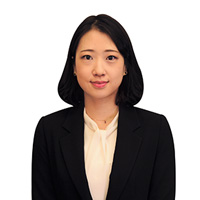





![[Today’s K-pop] Treasure to publish magazine for debut anniversary](http://res.heraldm.com/phpwas/restmb_idxmake.php?idx=642&simg=/content/image/2024/07/26/20240726050551_0.jpg&u=)